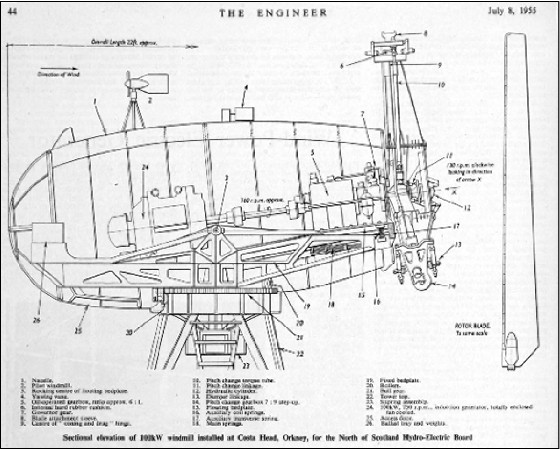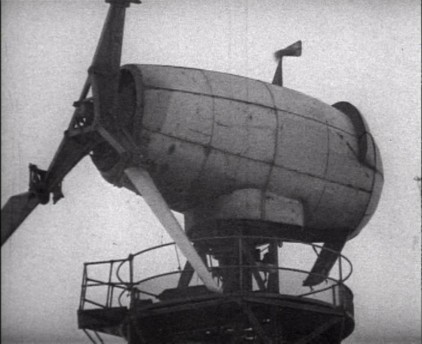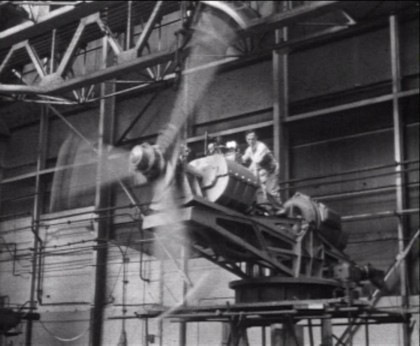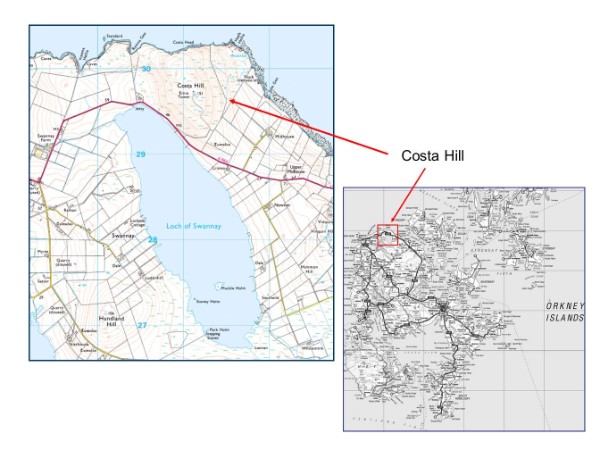_______________________________________________________________________________________________
Costa Head experimental wind turbine
The Orkney renewable energy industry began at Costa Head, with the construction and testing of a prototype wind turbine in the 1950s. This machine was developed by John Brown Engineering of Glasgow. The chosen site was perhaps too turbulent due to the high cliffs, and although the machine did not last very long, this project proved that wind energy generation was viable in Orkney.
The following is an extract from an edition of The Engineer issued in 1955

Electricity-generating wind turbines can be traced back to 1887 and James Blyth’s battery-charging machine, which was installed at the electrical engineer’s holiday home in Marykirk, Scotland. Nearly seven decades later, The Engineer received word from Costa Head, on the Orkney Mainland, about a 100kW wind-powered generator built by John Brown and Co (Clydebank) for the North of Scotland Hydro-Electric Board.
This wasn’t The Engineer’s first encounter with the machine. In 1950 the journal received notice that an order had been placed for the windmill and by 1955 full details had been disclosed.
Critics of wind power often ask where the electricity is going to come from when the wind stops blowing – an issue deemed almost irrelevant at Costa Head, on account of winds in excess of 125mph and ‘the comparative absence of calm days’. The generation target of 100kW was to be achieved with a wind speed of 30mph or above.
“This meant a blade circle of 60ft diameter, but later the ‘rated wind velocity’ was increased to 35mph, allowing the blade circle diameter to be decreased to 50ft,” wrote The Engineer.
In common with the machines that followed, the Costa Head windmill was built for completely automatic operation, ‘so that it should be possible to leave it entirely unattended for long periods’. It consisted of a three-bladed propeller and nacelle mounted on top of a seven-ton steel tower 78ft above the ground. By means of a step-up gearbox, the hub speed of 130rpm could be increased to 750rpm for driving the electric generator. Yawing of the nacelle was obtained by mounting it on a pintle shaft and turning it with a bull ring and pinion driven at reduced speed by an electric motor.
Unlike today’s glass and carbon fibre composite blades, the three blades for Costa Head consisted of a compressed laminated wood spar fitted with spruce ribs, which were covered by 3/32in mahogany plywood skin and protected with plastic.
“Inside each arm are fixed and moving pistons for varying the pitch of the blades,” The Engineer reported. “This is done hydraulically under the control of a servo-governor, the motion being transmitted through torque tubes and Hardy-Spicer couplings to quadrant boxes situated at the ends of the hub arms.”
Our correspondent added that each blade root was attached by a quick-release fork to a universal joint, allowing the blade to ‘cone’ and ‘drag’ at speed, which helped avoid excessive bending stresses at the roots.
“When the blade is at rest, this joint is automatically locked so as to hold the blade fixed.” The Engineer wrote. “The movement of the blades on their hinges is controlled by hydraulic dampers in order to prevent excessive vibration.”
A small ‘pilot’ windmill mounted on top of the nacelle controlled the starting and stopping of the windmill. To prevent the turbine being started by a sudden gust of wind, the pilot windmill averaged the wind speed over a number of minutes.
costa head experimental wind turbine
This short silent film is around 11 minutes long and is from the Scottish Screen Archive, licenced to Orkney Sustainable Energy. Downloading is not permitted.














